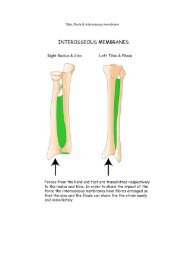GSM 11.14 - Version 5.2.0 - Digital cellular ... - Ttfn.net
GSM 11.14 - Version 5.2.0 - Digital cellular ... - Ttfn.net
GSM 11.14 - Version 5.2.0 - Digital cellular ... - Ttfn.net
You also want an ePaper? Increase the reach of your titles
YUMPU automatically turns print PDFs into web optimized ePapers that Google loves.
Page 16<br />
<strong>GSM</strong> <strong>11.14</strong> version <strong>5.2.0</strong>: December 1996<br />
6.2 Identification of proactive SIMs and of ME support<br />
A proactive SIM shall be identified by having the proactive SIM service activated in the SIM Service Table<br />
(see <strong>GSM</strong> 11.11 [14]). An ME that supports proactive SIMs shall be identified as such when it sends a<br />
TERMINAL PROFILE command during SIM initialization. The ME shall then send STATUS commands to<br />
the SIM at intervals determined by the poll interval procedure (see section 6.4.6).<br />
A proactive SIM shall not send any command requests (status bytes SW1 SW2 = "91 XX") to a mobile<br />
that does not support the proactive SIM feature.<br />
An ME that supports the proactive SIM feature shall not send proactive SIM related commands to a SIM<br />
that does not have the proactive SIM service activated.<br />
6.3 General procedure<br />
For all of the procedures that can end in "90 00" (indicating normal ending to the command), and which<br />
cannot end in "9F XX" (response data available from SIM), a proactive SIM operating with an ME that<br />
supports proactive SIMs may instead use the status response "91 XX".<br />
The response code "91 XX" shall indicate to the ME that the previous command has been successfully<br />
executed by the SIM in the same way as "90 00" (i.e. "OK"), but additionally it shall indicate response data<br />
which contains a command from the SIM for a particular ME procedure (defined in section 6.4).<br />
The value "XX" indicates the length of the response data. The ME shall use the FETCH command to obtain<br />
this data.<br />
<strong>GSM</strong> 11.11 [20] shows how the SIM can initiate a proactive command in each of the five cases of<br />
transmission protocol identified in <strong>GSM</strong> 11.11 [14]. Some commands require the SIM to indicate that it has<br />
response data for the ME (through SW1/SW2 = "9F XX"), and the ME gets this data using the GET<br />
RESPONSE command.<br />
When the ME has received a command from the SIM, it shall attempt to process the command<br />
immediately.<br />
- If the command has been successfully executed, the ME shall inform the SIM immediately, using<br />
TERMINAL RESPONSE.<br />
- If the command was not successfully executed, the ME shall inform the SIM immediately using<br />
TERMINAL RESPONSE with an error condition.<br />
Responsibility for re-trying lies with the SIM application. The SIM application can make a judgement<br />
whether to send the same command again, to send a different one, or not to try again, from the<br />
information given by the ME in TERMINAL RESPONSE. If the SIM application wishes the ME to try again,<br />
it shall issue a new (identical) command.<br />
6.4 Proactive SIM commands and procedures<br />
6.4.1 DISPLAY TEXT<br />
Four types are defined:<br />
- Display normal priority text on screen (packed format);<br />
- Display normal priority text on screen (unpacked format);<br />
- Display high priority text on screen (packed format);<br />
- Display high priority text on screen (unpacked format).








